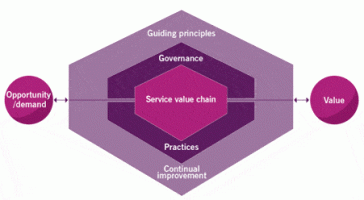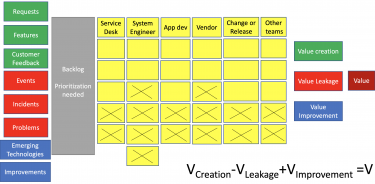Here’s something I wrote on adopting ITIL 4. As I undertake consultancy in IT, there are two ways I start engaging with my customers: a top–down or bottom–up approach. In the bottom–up approach, usually practitioners wish to see real examples of increasing the efficiency of their team or to just get some certifications to become more “competitive” in the market. Sometimes they receive too much work from other teams and don’t know how to deal with it, so they wish to design the best practice processes to measure their efficiency with specific KPIs and therefore seek help from my colleagues and me. The practitioners might wish to prevent or stop too much demand/opportunities entering their workflow.
This article looks to demonstrate the importance of the ITIL 4 service value system and how demand and opportunities enter the workflows in your organization. #ITIL4 #ITSM Share on XIn the top-down approach to adopting ITIL 4, the CEO or CIO recognizes the company’s real issues such as that sales aren’t increasing, a very slow increase in market share, or a decrease in customer satisfaction. And they recognize that the issue is the siloed work of the various teams, low employee motivation, or employees doing “no value” work. They also recognize that they don’t receive enough feedback and improvement opportunities from their teams.
In both situations, they likely don’t see the value of adopting ITIL 4. And we provide them a one-day workshop to demonstrate the importance of the ITIL 4 service value system and how demand and opportunities enter the workflows in their organization.
Adopting the ITIL 4 Service Value System
Based on what the customer tells us, we start by helping them to visualize and understand the service value system.

When adopting ITIL 4, that opportunity and demand can be divided into three categories – value creation, value leakage, and value improvement. I use different colors to differentiate them (as shown in the chart below).
- Value creation (shown in green): These types of work can create value. For example, new requests from the business, new features, or customer feedback, which can all bring in more revenue, increase market share, or increase or stop the decline in customer satisfaction.
- Value leakage (shown in red): These types of work don’t create any value, but if they occur they may bring about value or revenue leakage.
- Value improvement (shown in blue): These types of work don’t create value directly, but if you do them it can increase the capacity of your team or decrease the amount of “no value” work in the future. Value improvement can unblock the capacity which is used for manual work or other work (maybe supporting other systems or making reports) and can also decrease the number of future incidents or events.
The Value Formula
This is that:
Value = VCreation – VLeakage + VImprovement
After one day in a workshop, with all the stakeholders together and visualizing the work they’re doing, the business and IT start to come to an agreement on the prioritization of work based on value.
However, there are still moments when the conflicting KPIs of different teams cause issues and situations when there’s no clear vision of which work is the highest priority. So, there’s still a need for governance when adopting ITIL 4.
At the end of the short workshop exercise, we ask delegates, “What did you experience from applying ITIL 4 theory that you’ll now take away and try to apply in YOUR organization?”
Key Takeaways from Our ITIL 4 Value Workshops
- Use visualization to show the ITSM resource allocation across types of work and engage with the business to prioritize. Visualization gives everyone involved situational awareness. They can see exactly what must happen, what will be negative, and what can be improved. The visualization of goals, work, capacity used, prioritization, risks, workflow, and improvements.
- Adopting the ITIL 4 service value system helps to identify how work flows through the value chain. Value stream mapping binds all work together and provides a common view and understanding.
- Prioritization is now based on the value formula Value = VCreation – VLeakage + VImprovement and business cases are articulated in terms of value, outcomes, costs, and risks.
- Shift left – involve people earlier in work.
- Set clear goals for all team members.
- Continually improve. Blocked capacity prevents value creation and in order to get rid of this there’s a need for continual improvement. Map and record waste. Make a business case for improvement actions that need to be added onto the value stream backlog of work.
- Apply ITIL 4’s guiding principles. Recognize the importance of the “focus on value,” “collaborate and promote visibility,” and “progress iteratively with feedback” guiding principles in breaking down the silos and people working together.
After the workshops, the teams understand the importance of behavior change in order to achieve business goals. IT understands the need to focus on business language and on value. They recognize the importance of the alignment of business and IT goals to the strategic goals and mission of the organization. With one organization, it was an eye-opener for the product owner and the sales director when we showed them the complete value stream and the amount of work, as well as the amount of waste.
To really benefit from ITIL 4 there’s a need for cultural and behavioral change in organizations – which takes time. #ITIL4 #ITSM Share on XSo when adopting ITIL 4, there’s a need for cultural and behavioral change in organizations which takes time. So, they often seek help from us as coaches to help them work with the ITIL 4 guiding principles and continual improvement model. Ultimately, they are benefitting from the fact that ITIL 4 is not based only on processes or practices, it’s based on the co-creation of value and the end-to-end service value system.
If you liked this Adopting ITIL 4 article, the following ITIL articles might be of interest too.
Aray Kaken
Aray has been involved in the ITSMindustry for more than 8years.He has a broad background inProjectand ServiceManagement.Aray helps customers gain business value from Digital Transformationprograms based on ITSM approach. Heisalsoapproved ITIL trainer, ITILv3 Expert, ITIL4 Managing Professional. Now he works asPrincipalConsultantin Fox IT Kazakhstan.


